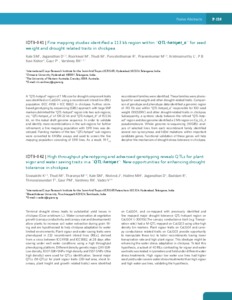Fine mapping studies identified a 113 kb region within “QTL-hotspot_a” for seed weight and drought related traits in chickpea
Abstract
A “QTL-hotspot” region of 7 Mb size for drought component traits was identified on CaLG04, using a recombinant inbred line (RIL) population (ICC 4958 × ICC 1882) in chickpea. Further, skimbased genotyping by sequencing (GBS) approach with large SNP markers delimited the “QTL-hotspot” region into two sub-regions; viz, “QTL-hotspot_a” of 139.22 kb and “QTL-hotspot_b” of 153.36 kb, on the kabuli draft genome sequence. In order to validate and identify more recombinations in the sub-regions for further refinement, a fine mapping population with 1,911 lines was developed. Flanking markers of the two “QTL-hotspot” sub-regions were converted to KASPar assays and used to screen the fine mapping population consisting of 1,911 lines. As a result, 19 F2:3 recombinant families were identified. These families were phenotyped for seed weight and other drought-related traits. Comparison of genotype and phenotype data identified a genomic region of ~113 Kb size within “QTL-hotspot_a” responsible for 100 seed weight (100SDW) and other drought-related traits in chickpea. Subsequently, a syntenic study between the refined “QTL-hotpsot” region and desi genome identified a 2 Mb region on Ca_LG_4 pseudomolecule. Whole genome re-sequencing (WGRS) analysis of selected lines from each recombinant family identified several non-synonymous and InDel mutations within important candidate genes. Functional validation of these genes will help decipher the mechanism of drought stress tolerance in chickpea

